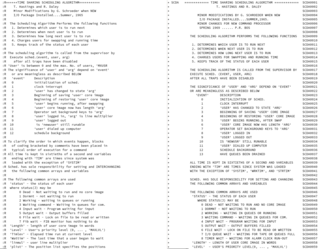IBM mainframes are large computer systems produced by IBM since 1952. During the 1960s and 1970s, IBM dominated the large computer market. Current mainframe computers in IBM's line of business computers are developments of the basic design of the IBM System/360.

A mainframe computer, informally called a mainframe or big iron, is a computer used primarily by large organizations for critical applications like bulk data processing for tasks such as censuses, industry and consumer statistics, enterprise resource planning, and large-scale transaction processing. A mainframe computer is large but not as large as a supercomputer and has more processing power than some other classes of computers, such as minicomputers, servers, workstations, and personal computers. Most large-scale computer-system architectures were established in the 1960s, but they continue to evolve. Mainframe computers are often used as servers.

Hercules is a computer emulator allowing software written for IBM mainframe computers and for plug compatible mainframes to run on other types of computer hardware, notably on low-cost personal computers. Development started in 1999 by Roger Bowler, a mainframe systems programmer.

The IBM 704 is a large digital mainframe computer introduced by IBM in 1954. It was the first mass-produced computer with hardware for floating-point arithmetic. The IBM 704 Manual of operation states:
The type 704 Electronic Data-Processing Machine is a large-scale, high-speed electronic calculator controlled by an internally stored program of the single address type.

The Conversational Monitor System is a simple interactive single-user operating system. CMS was originally developed as part of IBM's CP/CMS operating system, which went into production use in 1967. CMS is part of IBM's VM family, which runs on IBM mainframe computers. VM was first announced in 1972, and is still in use today as z/VM.

Gene Myron Amdahl was an American computer architect and high-tech entrepreneur, chiefly known for his work on mainframe computers at IBM and later his own companies, especially Amdahl Corporation. He formulated Amdahl's law, which states a fundamental limitation of parallel computing.
This article presents a timeline of events in the history of computer operating systems from 1951 to the current day. For a narrative explaining the overall developments, see the History of operating systems.

The Compatible Time-Sharing System (CTSS) was the first general purpose time-sharing operating system. Compatible Time Sharing referred to time sharing which was compatible with batch processing; it could offer both time sharing and batch processing concurrently.

CP/CMS is a discontinued time-sharing operating system of the late 1960s and early 1970s, known for its excellent performance and advanced features. It had three distinct versions:
The University of Michigan Executive System, or UMES, a batch operating system developed at the University of Michigan in 1958, was widely used at many universities. Based on the General Motors Executive System for the IBM 701, UMES was revised to work on the mainframe computers in use at the University of Michigan during this time and to work better for the small student jobs that were expected to be the primary work load at the University.
OfficeVision was an IBM proprietary office support application.
National CSS, Inc. (NCSS) was a time-sharing firm in the 1960–80s, until its acquisition by Dun & Bradstreet in 1979. NCSS was originally headquartered in Norwalk, Connecticut, but relocated to Wilton in 1978. Sales offices, data centers, and development facilities were located at various sites throughout the U.S. Some additional sales offices were active in the UK and elsewhere.
VP/CSS was a time-sharing operating system developed by National CSS. It began life in 1968 as a copy of IBM's CP/CMS, which at the time was distributed to IBM customers at no charge, in source code form, without support, as part of the IBM Type-III Library. Through extensive in-house development, in what today would be termed a software fork, National CSS took VP/CSS in a different direction from CP/CMS. Although the two systems would eventually share many capabilities, their technical implementations diverged in substantive ways.
The IBM Type-III Library was software provided by IBM to its customers, available without charge, liability, or support, and typically in source-code format. The best known examples are for mainframe software, but IBM also used this same classification on smaller systems.
ACF2 is a commercial, discretionary access control software security system developed for the MVS, VSE and VM IBM mainframe operating systems by SKK, Inc. Barry Schrager, Eberhard Klemens, and Scott Krueger combined to develop ACF2 at London Life Insurance in London, Ontario in 1978. The "2" was added to the ACF2 name by Cambridge Systems to differentiate it from the prototype, which was developed by Schrager and Klemens at the University of Illinois—the prototype name was ACF. The "2" also helped to distinguish the product from IBM's ACF/VTAM.
Applied Data Research (ADR) was a large software vendor from the 1960s until the mid-1980s. ADR is often described as "the first independent software vendor".
The SHARE Operating System (SOS) is an operating system introduced in 1959 by the SHARE user group. It is an improvement on the General Motors GM-NAA I/O operating system, the first operating system for the IBM 704. The main objective was to improve the sharing of programs.
The history of IBM mainframe operating systems is significant within the history of mainframe operating systems, because of IBM's long-standing position as the world's largest hardware supplier of mainframe computers. IBM mainframes run operating systems supplied by IBM and by third parties.
Linux on IBM Z or Linux on zSystems is the collective term for the Linux operating system compiled to run on IBM mainframes, especially IBM Z / IBM zSystems and IBM LinuxONE servers. Similar terms which imply the same meaning are Linux/390, Linux/390x, etc. The three Linux distributions certified for usage on the IBM Z hardware platform are Red Hat Enterprise Linux, SUSE Linux Enterprise Server, and Ubuntu.





